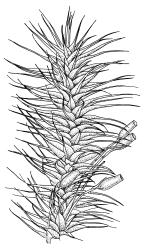Elements in the following description are taken from Sastre-De Jesús (1987). The family is assumed to be bigeneric.
Plants robust, forming loose tufts on tree trunks or rock, pendent and curving away from the substrate, usually ± yellow-green. Primary stems creeping, often eroded, in cross-section with central strand small or absent. Secondary stems (stipes) erect or pendent and curving away from the substrate, irregularly branched, dark brown and very stiff. Leaves of secondary stems and branches not differentiated, often eroding, erect-appressed, narrowly lanceolate and abruptly tapered from an oblong-obovate base; margins plane, singly toothed and often partially bistratose above, entire and unistratose at the base; laminal cells of the subula mostly oblong to elliptic, smooth, firm-walled, partially bistratose; interior cells of the leaf base linear, thick-walled, ± porose, smooth; marginal cells of the leaf base rounded-oblate to rounded-subquadrate in many rows and extending ± to the shoulder, mostly with fine, ± radiate cuticular striations; alar cells not differentiated; costa rather narrow, percurrent to short excurrent. Paraphyllia absent. Pseudoparaphyllia foliose.
Dioicous. Setae short to elongate; capsules exserted, erect and symmetric, oblong to oblong-cylindric; exothecial cells firm-walled, not thickened in corners; stomata superficial; annulus absent; operculum obliquely rostrate. Peristome double or single; exostome teeth 16, yellow-brown, linear-lanceolate, with a straight abaxial median line, baculate-spinose below or throughout; endostome present (in N.Z. taxon) or absent. Calyptra cucullate, smooth, naked.
The family Cyrtopodaceae was most recently reviewed bySastre-De Jesús (1987) who considered it to contain two genera, Cyrtopus and Bescherellia. Cyrtopus is monotypic and probably restricted to Australasia, while Bescherellia includes two species primarily distributed in Melanesia, Western Polynesia, and eastern Australia. Sastre-De Jesús excluded the New Caledonian Cyrtopodendron (placed here by Brotherus 1925) from the family and suggested that this monotypic genus is better placed in the Pterobryaceae (in the general relationship of Pterobryella). She emphasised the regularly pinnate branching of the secondary stems of Cyrtopodendron, noting that it is unlike the irregular branching of both Cyrtopus and Bescherellia.
Goffinet et al. (2009) recently placed the genera Cyrtopus and Bescherellia in the Hypnodendraceae, apparently accepting molecular evidence of a relationship presented by Bell et al. (2007). However, in an Australasian context, the Cyrtopodaceae are highly distinctive by several habitat and morphological features, including their predominantly epiphytic substrate, their pendent and strongly upwardly swept habit, their highly irregular (and non-dendroid) branching, their very long and narrowly lanceolate-acuminate leaves of a uniform shape, and the broad band of differentiated marginal cells at the leaf base. By contrast, members of the Hypnodendraceae are nearly always terrestrial and usually dendroid, lack an upwardly swept habit, have much shorter and less lanceolate (and dimorphic) leaves, and usually lack bands of differentiated marginal cells. The members of the Cyrtopodaceae are readily recognised in the field. Sastre-De Jesús’s (1987) family concept is therefore followed here. The family is also maintained in the classification utilised by the Flora of Australia vol. 51, based on Goffinet & Buck (2004).
| Category | Number |
|---|---|
| Indigenous (Non-endemic) | 1 |
| Total | 1 |




